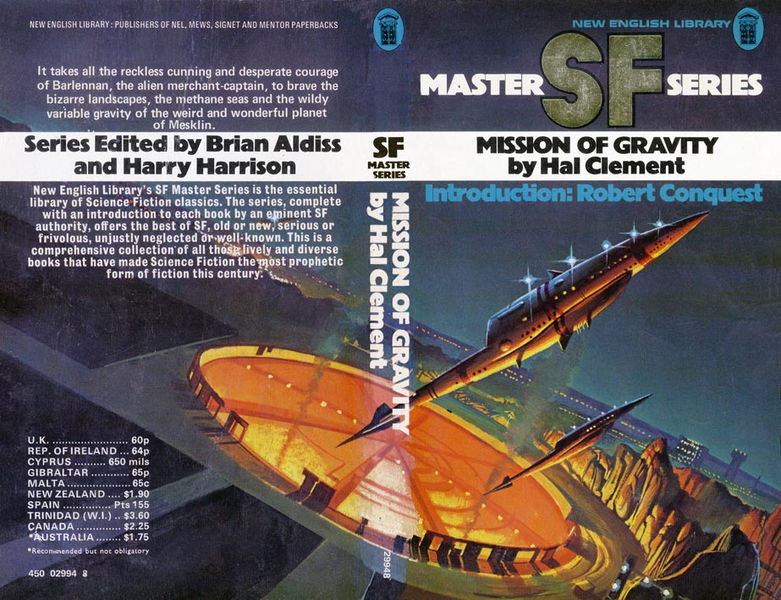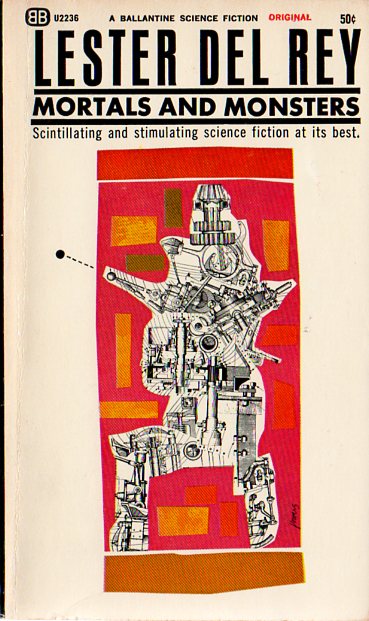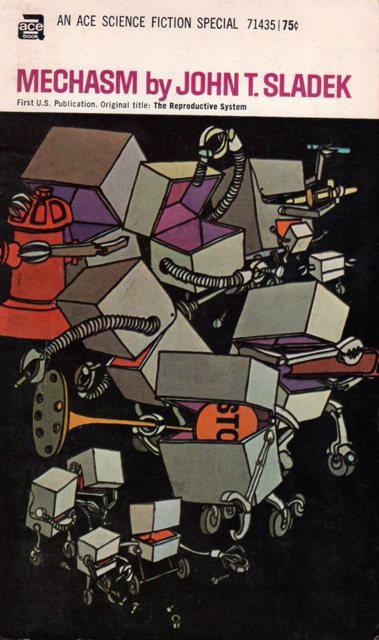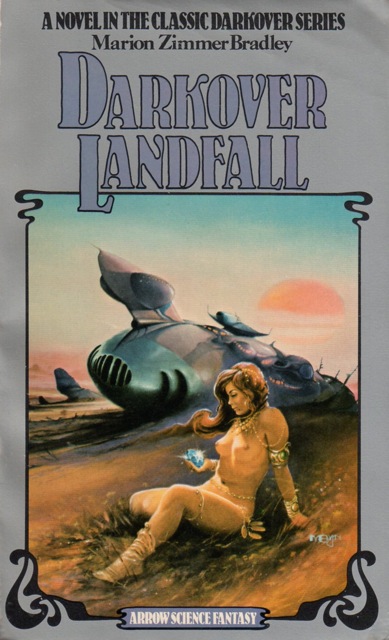(Don Sibley’s cover for the November 1950 issue of Galaxy)
When we conjure the image of a 40s/50s science fiction pulp heroine we often imagine a character who has to be rescued by men from aliens, shrieks and clings to any man nearby, and is always in a state of undress. I’ve included one cover, for the sake of comparison, that I find to be an exemplar of this type of sexist (and racist) depiction below (Alex Schomburg’s cover for the January 1954 issue of Future Science Fiction): white woman wrapped in only a towel stalked by an evil alien obviously painted with African-American facial characteristics (heavy on the sexual predation vibe) — the reader is supposed to buy into the racial stereotypes and thus be titillated by the fear she must feel.
I’ve selected a wide range of mostly pulp magazine covers depicting spacewomen of the future (I’ve loosely decided that this means women in space, in spacesuits) that tend to buck the trend (obviously, the artist’s depiction might differ from the author’s characterization). I’ve refrained from calling them female astronauts because in the stories they might be women forced to put on space gear and trek across barren landscapes. For example, Don Sibley’s cover for the November 1950 issue of Galaxy illustrates Frederic Brown’s story ‘Honeymoon in Hell’ where a newly wed couple is stranded on the moon. The illustration is simply amazing! The women repairs the spaceship while the husband brings extra oxygen.
These illustrious women lead the charge across barren landscapes (Laurence Steven’s delightful cover for the April 1951 issue of Super Science Stories), defend their spaceships from pink aliens (Earle K. Bergey’s cover for the December 1952 issue of Space Stories), compute the courses for spaceships (Ed Emshwiller’s cover for the November 1953 issue of Galaxy), drive lunar skimmers while men toss grenades (Ed Emshwiller’s cover for the 1958 edition of Brigands of the Moon (1930), Ray Cummings), and even shoot aliens while skiing! (Earle K. Bergey’s cover for the December 1946 issue of Thrilling Wonder Stories).
Many of the pulp-era spaceswomen I’ve found are still sexualized for the sake of titillating the fourteen year old demographic. The number one way to achieve this was to invent revealing spacesuits. Some are quite hilarious: a bikini spacesuit wouldn’t be terribly useful in the void of space nor would trekking across rocky planets in a miniskirt be comfortable. Artists often go to great length to still show skin despite wearing more “realistic” full body spacesuits — two of the covers below depict women draped in transparent plastic (it must be futuristic incredibly thin puncture proof plastic!)…
*note: sometimes the spacewoman is far in the background and hard to see. A few of the covers might not fit the theme perfectly, alas…
I have multiple more images lined up for a Part II. As aways, if you know of any I’ve missed let me know.
What are your favorites?
Enjoy!
(Alex Schomburg’s cover for the January 1954 issue of Future Science Fiction)
(Laurence Steven’s cover for the April 1951 issue of Super Science Stories)

(Ed Emshwiller’s cover for the March 1953 issue of Thrilling Wonder Stories (UK edition)
(Earle K. Bergey’s cover for the December 1952 issue of Space Stories)
(Earle K Bergey’s cover for the Summer 1951 issue of Fantastic Story Magazine)
(Karel Thole’s cover for the 1970 edition of Farewell, Earth’s Bliss (1966), D. G. Compton)
(Kelly Freas’ cover for the April 1956 issue of Fantastic Universe Science Fiction)
(Ed Emshwiller’s cover for the June 1958 issue of Infinity Science Fiction)
(Earle K. Bergey’s cover for the December 1941 issue of Thrilling Wonder Stories)
(Earle K. Bergey’s cover for the August 1951 issue of Thrilling Wonder Stories)
(Earle K. Bergey’s cover for the December 1946 issue of Thrilling Wonder Stories)

(Earle K. Bergey’s cover for the Winter 1946 issue of Startling Stories)
(Uncredited cover for The Year’s Best Science Fiction Novels (1952), ed. Everett F. Bleiber and T. E. Dikty)
(Milton Luros’ cover for the August 1952 issue of Science Fiction Quarterly)
(Milton Luros’ cover for the November 1952 issue of Science Fiction Quarterly)
(Milton Luros’ cover for the Febuary 1952 issue of Science Fiction Quarterly)
(Ed Emshwiller’s cover for the April 1960 issue of Galaxy)
(Walter Popp’s cover for the Spring 1954 issue of Thrilling Wonder Stories)
(Ed Emshwiller’s cover for the November 1953 issue of Galaxy)
(Ed Emshwiller’s cover for the 1958 edition of Brigands of the Moon (1930), Ray Cummings)
(Ed Emshwiller’s cover for the 1962 edition of Secret Agent of Terra (1962), John Brunner)
(Ed Emshwiller’s cover for the 1958 issue of Science Fiction Adventures)

(Norman Saunders’ cover for the February 1951 issue of Marvel Science Stories)
(Malcolm Smith’s cover for the 1951 edition of Space on My Hands (1951), Frederic Brown)
 (Claude Newkirk’s cover for the November-December issue of Galaxy Magazine)
(Claude Newkirk’s cover for the November-December issue of Galaxy Magazine)
(Jack Gaughan’s cover for the September-October issue of Galaxy Magazine)
(A. Leslie Ross’ cover for the December 1952 issue of Dynamic Science Fiction)
(Hubert Rogers’ cover for the July 1940 issue of Astounding Science Fiction)
(Ed Emshwiller’s cover for the 1964 issue of I Want the Stars (1964), Tom Purdom)
(Ed Valigursky’s cover for the June 1958 issue of Amazing Science Fiction Stories)
(Ron Turner and Reginald Heade’s cover for the 1956 edition of One Against Tomorrow (1956), Hank Janson)
 (Malcolm Smith’s cover for the 1950 edition of Worlds Within (1950), Rog Phillips)
(Malcolm Smith’s cover for the 1950 edition of Worlds Within (1950), Rog Phillips)
For similar posts consult the INDEX
Filed under: Science Fiction cover art Tagged: 1940s, 1950s, 1960s, 1970s, aliens, art, British, D. G. Compton, jack vance, john brunner, pulp, Robert Silverberg, sci-fi, science fiction, Short stories, space opera, spaceships, technology







































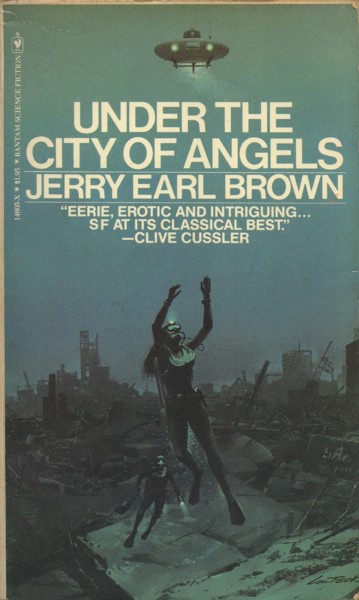






























































 (Tim Newling’s childlike scrawl of a cover for the 1966 edition)
(Tim Newling’s childlike scrawl of a cover for the 1966 edition)























